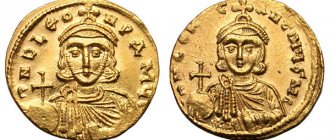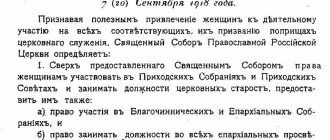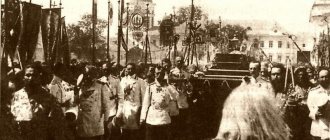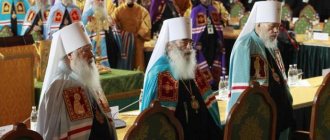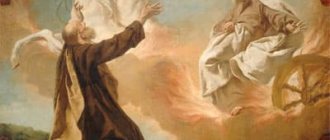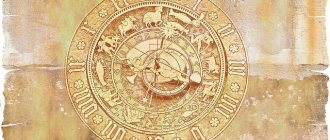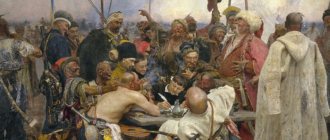Councils are long-standing traditions of the church, going back to the time of the apostles. The New Testament mentions this, giving information about the convening of one of them in Jerusalem.
Having survived the era of persecution of Christians, the church in the 4th century created an institution of a higher order on a conciliar basis. These are Ecumenical Councils. They can be compared to “milestones” - they count down the time periods of the church’s evolution and reinforce its dogmas.
general characteristics
The history of the birth of the Christian Church is clouded by conflicts. In its most acute periods, the highest rank clergy were called to a council-discussion.
Meetings at which the highest clergy, convened according to a hierarchical principle, formulate canonical norms of doctrine and proclaim the fight against heresies are called Ecumenical.
To be recognized as such, they must have certain external and internal features.
External signs
The church structure is subject to a hierarchical principle.
The main department of the central metropolis is based on a college of presbyters who govern the lower dioceses and parishes. There is a hierarchy within parishes.
To convene the highest meeting of the clergy, it is necessary to observe external signs:
- Participation of the highest representatives of parishes - elders and commissioners.
- Compliance with the principle of hierarchy among delegates.
- The existence of regulations for resolving problems affecting religious doctrine.
- Recognition of this congress by all local churches.
The answer to the question of how many councils were recognized by the Ecumenical Orthodox, Catholic, Protestant and Ancient Eastern churches is ambiguous.
Recognition of meetings of the highest rank by the Ecumenical various Christian churches is distributed as follows.
Internal signs
The state religion is under the patronage and control of secular authorities. Such a connection confronts it with the task of inviolability of theological thought and dogma.
It is quite obvious that the head of state (especially the empire) is aimed at strengthening it with the help of the church. Therefore, it is important to exclude disputes that lead to resonance among the most authoritative clergy.
But history shows that the conditions of the environment and the current moment often violated church harmony. Therefore, there was a need for meetings of all parishes.
The internal requirements for convening the highest ecclesiastical ranks are:
- Compliance of the topic of discussion with the traditions of the apostles and the Holy Scriptures and the generally accepted dogmas of the Universal Church.
- Unanimous acceptance of the rules of the meeting by local churches.
Causes and background of the councils
The most ancient centers of Hellenic culture, struck by the imperial ambitions of Rome, ceased to inspire confidence. The relevance of the new dogma has matured.
The racial, cultural and religious mentality of Europeans determined Christianity as a new religion for resolving pressing moral issues. Its foundation was laid in the east of the empire by Emperor Constantine.
Christianity actually saved the Roman Empire, which had entered a state of collapse. But it was not possible to completely stop the division.
In the process of synthesis of Christianity and the struggle for the primacy of dioceses at church congresses, a natural process of crystallization of dogmas took place.
The prerequisites for the councils were debates on theological topics. And the actual reasons are often the internecine struggle for the primacy of the patriarchs of Rome, Constantinople, Alexandria, Antioch and Jerusalem.
The principle of decision-making by councils was always the same - those who disagreed were expelled from parishes, anathematized, and the ideological inspirers of heresy were exiled.
As the entire history of the church has shown:
- The western part of the Roman Empire demanded unification before the “end of the world” around the Pope.
- The Eastern one tried to create a hierarchy independent of Rome and lay eternal dogmas as the basis for its religious concept, adhering to the teachings of the Apostles.
The course of events in the Councils known to history
The Ecumenical Orthodox Church illustrated freedom of thought: the natural evolutionary stages of the history of Eastern Christianity were marked by the struggle for doctrine at its councils.
Apostolic (around 49)
The Jerusalem Council was the first, as evidenced by the New Testament in the Gospel of Luke (Acts 15:1-1) and the letters of the Apostle Paul (Gal. 2:1-10).
The historical context of the dispute concerned the issue of the dependence of the path to salvation for pagans who accept faith in Christ:
- from circumcision according to the historical tradition of the Jews;
- from grace by faith.
Church leaders Paul and Barnabas (former pagans) disagreed with the Jewish preachers who insisted on circumcision. They went to resolve the dispute with the Apostles in Jerusalem.
At the council, the floor was initially given to those who came. They motivated the refusal of circumcision by the lack of national tradition among peoples wishing to be baptized. In addition, they shared their joy about the successful preaching of Christianity among the pagans. Then their opponents made a speech about keeping the law of Moses.
The responsibility for the decision lay with the Apostles.
It was difficult and new for Christians because:
- the first Christian communities consisted only of Jews;
- circumcision was not a national pagan tradition.
The Apostle Peter understood the complexity of the situation. She assumed that new brothers in Christ, non-Jews, should change their lifestyle for the sake of baptism. The main conclusion of his appeal is “it is important for God to have a pure heart.”
The First Council broke down barriers for those who were not Jews but wanted to become Christians - they could be baptized without circumcision. The verdict of the presiding judge was: “Accept the laws of Moses, relating only to morality and fasting, but not to traditions.”
Thus, at the Apostolic Council:
- the wishes of the Jews were partially satisfied;
- the road to faith became open to the pagans.
First - Nicene
Initially, the main axis of the creation of peace and church unity was Constantine I the Great (272 - 237). During his ascent to autocracy, he sought to create a Catholic Church. His banner was Jesus Christ. During this period, a theological dispute occurred between Arius and the episcopate of Alexandria.
Doctrine of Arius:
- brought down the Trinity of Persons in the Godhead;
- gave birth to heresy;
- betrayed Christology, crossing out the basis of Christianity and translating its entire essence into moralism;
- veiled the objective mystery of redemption - “You yourself, Lord, became incarnate and saved me, all mankind.”
Bishop Alexander of Alexandria excommunicated the Aryan clergy and expelled his like-minded people from the city.
Having learned from the bishop of the capital Nicomedia Eusebius (defender of Arius) about the theological dispute, Constantine began to “put out the fire” of disagreements. Under the influence of Eusebius, he forbade Alexander of Alexandria from persecuting the Aryans. But he showed persistence and, through Bishop Hosius, convinced Constantine of the heresy of Arius.
It was decided to hold the First Ecumenical Council in Nicaea in 325. This enterprise became a novelty in the history of the degenerating empire. It “breathed” into her the idea of a new scale.
Having become emperor, Constantine did not forget the role of Hosius. He was called to court and surrounded with honor.
Second - First Constantinople 381
The development of Christianity required the establishment of a system of primacy in the One Universal Church and the consolidation of the symbols of faith.
In the Roman Empire, events occurred that separated east and west:
- in the West theologized about a moral ethic aimed at the fear of the end of the world;
- in the east there was a struggle for theology, “polishing” all its facets.
Therefore, the question of the primacy of honor was raised. The decision read:
“Let the Bishop of Constantinople have the advantage of honor after the Bishop of Rome, since Constantinople is the New Rome.”
II Ecumenical Council
Despite the fact that the decree of the Second Ecumenical Council has not survived, it is known that it:
- was assembled by order of Emperor Theodosius the Great in Constantinople;
- like the Council of Nicea, established the “Trinitarian dogma”;
- first introduced the title of “metropolitan”;
- prescribed a special “observance of honor” (but not power), creating a system of patriarchal supremacy in the One Ecumenical Church (Rome, Constantinople, Alexandria, Antioch, Jerusalem).
Third - Ephesus 433
Thin threads of the large-scale conflict of the 5th century are imprinted with the names of Cyril and Nestorius. The solution to the problem that affected the mystery of God and the God-man fell to the ancient city of Ephesus in 431-433.
Nestorius was inferior to his opponent from Alexandria, Cyril, in the art of gathering like-minded people. But both took steps that would tear apart the church, for which the universe is one faith, one temple.
The next Ecumenical Council temporarily extinguished the fire of disagreement between the two rivals.
The warring parties were forced to retract their statements:
- Cyril lifted the anathemas from the supporters of Nestorius;
- Nestorius admitted that he had committed a frivolous misunderstanding in his teaching about the Mother of God.
Fourth - Chalcedon 451
Ironically, the beginning of the IV Ecumenical Year was the last year (the sixth year) of Nestorius’s exile. An old man with a broken fate, but a strong will, did not let go of his pen until his last days. His "Commerce of Heraclides" is a treatise of repentance. It is written as a dialogue between Nestorius and Sophronius (a fictitious name for Cyril).
During the same period, a fire of heresies broke out between the Monophysites and Diphysites, their perverted understanding of the teachings of Cyril and Nestorius.
The instigators of the dispute about “what remains in Christ after the union” were divided into three groups:
- the Monophysites (interpreters of Cyril) argued - one nature, one hypostasis, one person;
- diphysites (interpreters of Cyril) - two natures, one hypostasis, one person;
- diphysites (interpreters of Nestorius) - two natures, two hypostases and one person.
Rule 28 of the Council of Chalcedon became important for Byzantium: the See of Constantinople has the same advantages as the See of Rome. But the main decision of Chalcedon was the verdict:
“Christ, Son, Lord, Only Begotten, cognizable in two natures (εν δύο φύσεσιν) unfused, unchangeable, inseparable, inseparable.”
Dogma of the Chalcedonian Ecumenical
Those who denied dogma initially blocked access to heretical tendencies. But the barrier against heresies was too thin not to be destroyed. The attempt at destruction was not long in coming.
Under Emperor Anastasia, the heresy of the Monophysites intensified:
- The source of tension in relations with the episcopate was the Monophysite monk from Sozopol (Pisidia) - Sevier, who was supported by the East.
- The Imperial Church adhered to the teachings of the Diphysites. She entered into confrontation with the Monophysites, but was not supported by secular authorities.
- In 512, the diocese of Constantinople underwent great changes - the Monophysite “Trisagion” was introduced.
- Anastasius refused to show respect to the Pope.
Consequences of withdrawal:
- The Monophysite Trisagion caused a riot in the crowd. She beheaded the Monophysite monk and overthrew the statues of Anastasius.
- Rome and the old episcopate of Byzantium took advantage of the turmoil and supported the military leader Vitalian and his military actions against Emperor Anastasius.
- After the death of Emperor Anastasius, Rome placed its protégé Julian on the throne.
Fifth - Second Constantinople 553
From Council to Council, shocks and conflicts were repeated with persistent frequency. A new fire of Monophysitism flared up.
At the stage of transition from antiquity to the Middle Ages, Byzantium was ruled by the protege of Rome, Julian. He obligingly met the Pope's delegates and fulfilled their conditions. And Rome demanded its elevation above Constantinople and anathema to the Monophysites.
Justinian I (483-565), Julian's successor, had a flexible mind and high education.
He tried to play two games at the same time:
- Please the Monophysites.
- Adhere to the authority of the Council of Chalcedon.
Justinian I laid the foundation of the V Ecumenical Council. His reign became the second stage (after Constantine the Great) in the formation of a monolithic Christian empire in the East.
At the council of 553:
- confirmed the decision of the fourth;
- the followers of Plato, Nestorius, Arius, and Origen were condemned.
Sixth - Third of Constantinople (680 - 681, 692)
The Monophysites of the East could not accept their defeat and continued to fight. Byzantine power was overshadowed by a bleak legacy: an empty treasury, a bad army and the constant pressure of enemies: Arabs, Avars, Persians and the rebellion of Phocas.
Emperor Constantine IV Pogonatus needed to strengthen power and reconcile the two thrones (Roman and Constantine).
At the Sixth Council the most authoritative theologians:
- Recognized the supremacy of the Universal Church.
- They condemned the false teachings of the Monophysites.
Trulli are the vaults of the hall in which the Ecumenical III of Constantinople was held. It was also held there as an additional to the Third, Trullan.
The idea of holding it belongs to Emperor Justinian II. It is polemically aimed at condemning certain rules of the Roman Church.
In 692 they canceled:
- forcing priests and deacons to celibate;
- strict fasts on Saturdays of Great Lent;
- image of Christ in the form of a lamb (lamb).
Among the decisions that, in the opinion of modern people, is considered Zionism, was a ban on close communication with the Jews.
Seventh - Second Nicene 787
The term “iconoclasm” is a short preview of the Seventh Ecumenical. This movement appeared in the 7th century. It acted in unison with Islam, which was advancing on a broad front against Christianity.
The Byzantine emperors themselves also sought benefit from it. In their opinion, the church interfered with the accumulation of treasury for the militant state program.
Names of iconoclast emperors:
- Leo the Isaurian (717 - 741);
- Constantine V (741 - 775);
- Leo IV Khazar (775 - 780).
After Leo IV, who became infected with cadaveric poison from the crown of Mauritius, the rule of Byzantium passed to regent Irene. She was the mother of Leo's young son, Konstantin. She had previously been expelled by her husband for venerating icons.
Thanks to Irina, the city of Nicaea took on the mission of saving Orthodoxy and rejected the advances of the iconoclasts for some time.
Apostolic canons with interpretations
The public and secret life of the church is revealed by the rules of the holy Apostles.
Historical reference
The public mention of the rules of the Apostles dates back to the Council of Trullo, the theme of which was discipline in the holy bosom of Christianity.
“...so that from now on... the eighty-five rules accepted and approved by the holy and blessed fathers who lived before us, as well as the eighty-five rules handed down to us in the name of the holy and glorious Apostles, remain firm and indestructible.”
2nd Rule of the Council of Trullo, 692
There are opinions that the rules of the Apostles were compiled:
- by the Apostles and transmitted through the 4th Pope Clement;
- according to the norms in force since apostolic times;
- bishops at the beginning of the 4th century;
- by an anonymous author in the 5th century.
Essence and content
Until now, these rules are fully recognized only by the Orthodox Church. Their authority was gained partially and gradually. Some churches refused to accept them into their code.
The essence of the rules is consistent with the theme of the Trullo Cathedral. These are discipline, hierarchy and moral qualities of the clergy.
The Importance of Rules for the Church
Church canons are the cornerstones of faith. These include the most important rules of the early centuries of the Church, named after the Apostles.
The apostolic works bear witness to:
- the joy of the church finding “much gain”;
- faith that they are “enlightened” by the one Spirit;
- consent of churches to anathematize or excommunicate and subject to penances according to the rules.
Notes
- Athanasius the Great was then still an archdeacon and was not a full participant in the council, but participated in the disputes, like the heretic Arius.
- [www.newadvent.org/fathers/2819.htm Ad Afros Epistola Synodica]
- This number was assigned a symbolic meaning: the number of warriors - slaves of Abraham (Gen. 14.14) and, also: the Greek numbers T IH (318) depict the Cross and the first 2 letters of the name Jesus Christ.
- Smirnov, 1888, p. 18.
- Beneshevich V. N.
Sinai list of the fathers of the Nicene First Ecumenical Council // St. Petersburg: type. Imp. Academician Sciences, 1908. - P. 281-306. - Brilliantov A.I.
Lectures on the history of the ancient church. - St. Petersburg: Oleg Abyshko Publishing House, 2007. - 480 p. — ISBN 978-5-9900890-3-7. - Rufinus counted 17, Philostorgius - 22.
- [www.sedmitza.ru/lib/text/435459/ Rules of the First Ecumenical Council of 325 in Nicaea]
Pan-Orthodox Cathedral
In 2016, the Great Pan-Orthodox Council took place in the Greek settlement of Kolymvari. Ten of the fourteen local churches took part.
This meeting has been prepared since the beginning of the 20th century. It was generated by deep crises, challenges for the church and the emergence of new autocephalies. In 1961, a list of issues was agreed upon at Rhodes. In 1976 they were reduced to ten, as the rest were considered ambitious. The greatest debate was caused by the issue of autonomy.
There have been conflicting views that the new autonomies will lead to:
- weakening of the privileges of the Ecumenical Patriarchate and the unity of the church;
- violation of the canonical system of autonomy.
As a result, on the issue of autonomies, a compromise resolution was adopted that the institutions of autonomy canonically acquire the status of relative independence from their autocephaly.
The Russian, Antiochian, Georgian and Bulgarian autocephalies refused to participate in the council. Therefore, he is not Universal.
Literature
- [www.pravenc.ru/text/155490.html Ecumenical Council I] // Orthodox Encyclopedia. Volume IX. - M.: Church-scientific, 2005. - P. 571-580. — 752 p. — 39,000 copies. — ISBN 5-89572-015-3
- Smirnov K.
Review of the sources of the first ecumenical Council of Nicaea. - Yaroslavl, 1888. - 358 p. ([static.my-shop.ru/product/pdf/89/882217.pdf Reprint. - M.: Book on Demand. - 2011. - 366 pp.]) - Lebedev A.P.
[dlib.rsl.ru/viewer/01003592132#?page=1 Ecumenical Councils of the 4th and 5th centuries: Review of their dogmatic activities...] - M.: type. L.F. Snegireva, 1879. - 284 p. - [dlib.rsl.ru/viewer/01003830780#?page=1 Acts of the Ecumenical Councils. - Kazan. - T. 1. - 1859. - 912 pp.] ([www.omolenko.com/istoria/sobory-tom1.htm?p=1#toc10 3rd edition. - Kazan. - T. 1. - 1910] )
Results and consequences of events
Many predicted that the decisions of the last Pan-Orthodox Council would become the impetus for a schism. The Ukrainian Church was named as the first contender.
These fears have begun to come true these days:
- The Ukrainian Church is torn away from its mother church and brought under the control of the Church of Constantinople.
- There is a split in the Orthodox world through the falsification of interfaith relations by Western media.
History knows examples of manipulation at the beginning of the 20th century. The Russian Orthodox Church was obliged to switch to the Gregorian calendar. She withstood this pressure and survived, preserving her traditions.
The second danger posed by the activities of Patriarch Bartholomew of Constantinople (organizer of the Pan-Orthodox Council) is ecumenism. It promotes the acceptance of Protestants into the church, which will undoubtedly give rise to the growth of heresy.
The only sure way out of the current crisis is to stick to your Church.
Links
- Wikimedia Commons has media related to First Council of Nicaea
- Kartashev A.V.
Eastern Church Trullo Cathedral | Fourth Council of Constantinople (Sophia) | Fifth Council of Constantinople | Jerusalem Cathedral | Pan-Orthodox Cathedral Western Church Fourth Council of Constantinople | First Lateran Council | Second Lateran Council | Third Lateran Council | Fourth Lateran Council | First Lyon Cathedral | Second Lyon Cathedral | Vienne Cathedral | Cathedral of Constance | Ferraro-Florence Cathedral | Fifth Lateran Council | Council of Trent | First Vatican Council | Second Vatican Council Robber Cathedrals Antioch Cathedral | Milan Cathedral | Ephesus "Robber" Cathedral | first Iconoclastic Council | Second Iconoclastic Council
